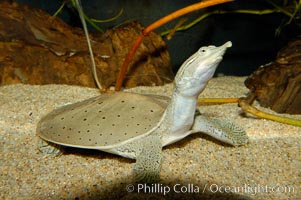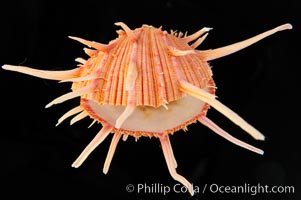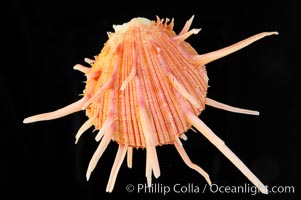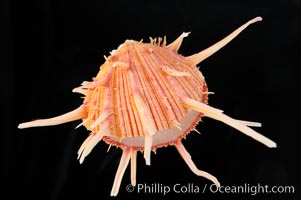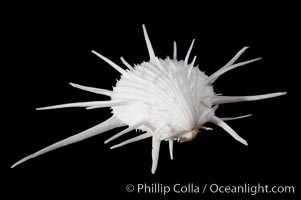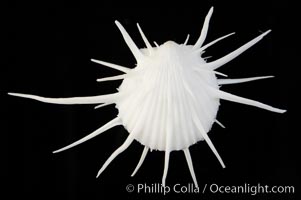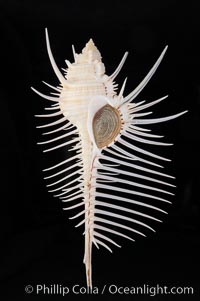
Venus comb murex. Scientists speculate that the distinctively long and narrow spines are a protection against fish and other mollusks and prevent the mollusk from sinking into the soft, sandy mud where it is commonly found.
Species: Venus comb murex, Murex pecten
Image ID: 12970
Species: Venus comb murex, Murex pecten
Image ID: 12970
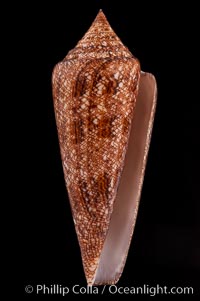
Glory of the Sea cone shell, brown form. The Glory of the Sea cone shell, once one of the rarest and most sought after of all seashells, remains the most famous and one of the most desireable shells for modern collectors.
Species: Glory of the seas cone, Conus gloriamaris
Image ID: 08732
Species: Glory of the seas cone, Conus gloriamaris
Image ID: 08732
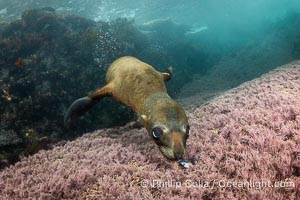
Young California Sea Lion Discovers a Seashell, Coronado Islands, Baja California, Mexico.
Species: California sea lion, Zalophus californianus
Location: Coronado Islands (Islas Coronado), Baja California, Mexico
Image ID: 36536
Species: California sea lion, Zalophus californianus
Location: Coronado Islands (Islas Coronado), Baja California, Mexico
Image ID: 36536
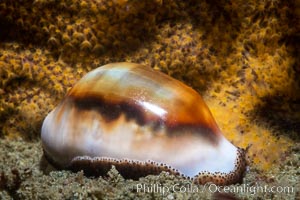
Chestnut cowrie with mantle withdrawn, in front of golden gorgonian.
Species: Chestnut Cowrie, Date Cowrie, Cypraea spadicea
Location: San Diego, California
Image ID: 37289
Species: Chestnut Cowrie, Date Cowrie, Cypraea spadicea
Location: San Diego, California
Image ID: 37289
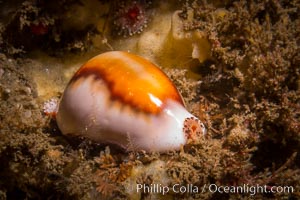
Chestnut cowry.
Species: Chestnut cowrie, Date cowrie, Cypraea spadicea
Location: San Diego, California
Image ID: 34206
Species: Chestnut cowrie, Date cowrie, Cypraea spadicea
Location: San Diego, California
Image ID: 34206
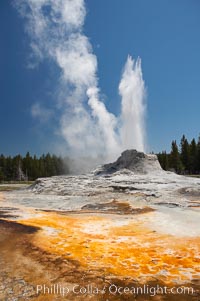
Castle Geyser erupts with the colorful bacteria mats of Tortoise Shell Spring in the foreground. Castle Geyser reaches 60 to 90 feet in height and lasts 20 minutes. While Castle Geyser has a 12 foot sinter cone that took 5,000 to 15,000 years to form, it is in fact situated atop geyserite terraces that themselves may have taken 200,000 years to form, making it likely the oldest active geyser in the park. Upper Geyser Basin.
Location: Upper Geyser Basin, Yellowstone National Park, Wyoming
Image ID: 13426
Location: Upper Geyser Basin, Yellowstone National Park, Wyoming
Image ID: 13426
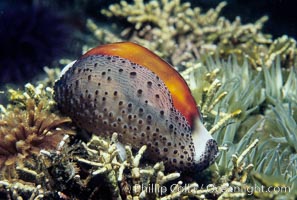
Chestnut cowrie with mantle extended, feather duster worm.
Species: Chestnut cowrie, Date cowrie, Cypraea spadicea, Eudistylia polymorpha
Location: Santa Cruz Island, California
Image ID: 01061
Species: Chestnut cowrie, Date cowrie, Cypraea spadicea, Eudistylia polymorpha
Location: Santa Cruz Island, California
Image ID: 01061
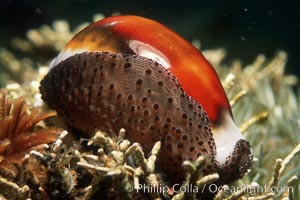
Chestnut cowry, mantle exposed.
Species: Chestnut cowrie, Date cowrie, Cypraea spadicea
Location: San Miguel Island, California
Image ID: 00624
Species: Chestnut cowrie, Date cowrie, Cypraea spadicea
Location: San Miguel Island, California
Image ID: 00624
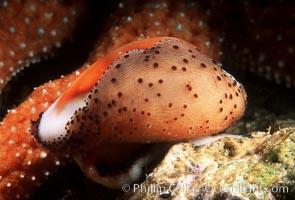
Chestnut cowrie with mantle extended.
Species: Chestnut cowrie, Date cowrie, Cypraea spadicea
Location: San Miguel Island, California
Image ID: 01062
Species: Chestnut cowrie, Date cowrie, Cypraea spadicea
Location: San Miguel Island, California
Image ID: 01062
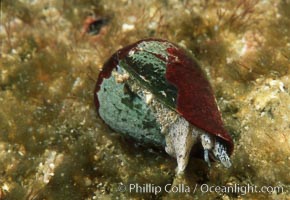
Califonia cone, Coronado Islands.
Species: California cone, Conus californicus
Location: Coronado Islands (Islas Coronado), Baja California, Mexico
Image ID: 02551
Species: California cone, Conus californicus
Location: Coronado Islands (Islas Coronado), Baja California, Mexico
Image ID: 02551
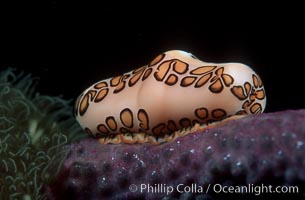
Flamingo tongue snail.
Species: Flamingo tongue cowrie, Cyphoma gibbosum
Location: Roatan, Honduras
Image ID: 02554
Species: Flamingo tongue cowrie, Cyphoma gibbosum
Location: Roatan, Honduras
Image ID: 02554
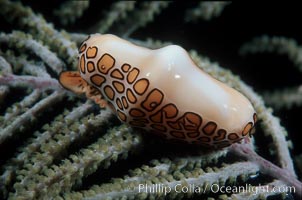
Flamingo tongue snail.
Species: Flamingo tongue cowrie, Cyphoma gibbosum
Location: Roatan, Honduras
Image ID: 02567
Species: Flamingo tongue cowrie, Cyphoma gibbosum
Location: Roatan, Honduras
Image ID: 02567
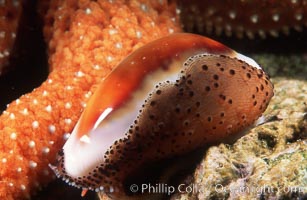
Chestnut cowrie with mantle extended.
Species: Chestnut cowrie, Date cowrie, Cypraea spadicea
Location: San Miguel Island, California
Image ID: 01035
Species: Chestnut cowrie, Date cowrie, Cypraea spadicea
Location: San Miguel Island, California
Image ID: 01035
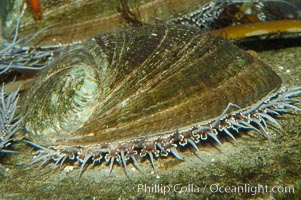
Green abalone with mantle fringe visible extending outside shell.
Species: Green abalone, Haliotis fulgens
Image ID: 09242
Species: Green abalone, Haliotis fulgens
Image ID: 09242
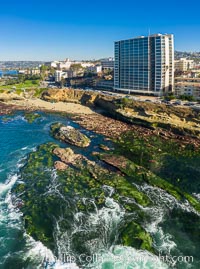
Shell Beach Reef Exposed at Extreme Low Tide, La Jolla, California.
Location: La Jolla, California
Image ID: 37988
Location: La Jolla, California
Image ID: 37988
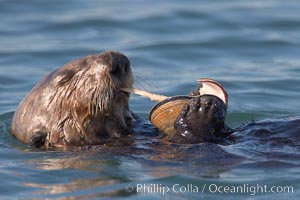
A sea otter eats a clam that it has taken from the shallow sandy bottom of Elkhorn Slough. Because sea otters have such a high metabolic rate, they eat up to 30% of their body weight each day in the form of clams, mussels, urchins, crabs and abalone. Sea otters are the only known tool-using marine mammal, using a stone or old shell to open the shells of their prey as they float on their backs.
Species: Sea otter, Enhydra lutris
Location: Elkhorn Slough National Estuarine Research Reserve, Moss Landing, California
Image ID: 21612
Species: Sea otter, Enhydra lutris
Location: Elkhorn Slough National Estuarine Research Reserve, Moss Landing, California
Image ID: 21612
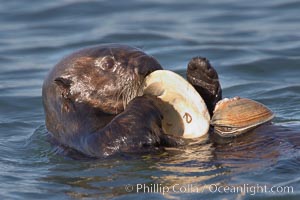
A sea otter eats a clam that it has taken from the shallow sandy bottom of Elkhorn Slough. Because sea otters have such a high metabolic rate, they eat up to 30% of their body weight each day in the form of clams, mussels, urchins, crabs and abalone. Sea otters are the only known tool-using marine mammal, using a stone or old shell to open the shells of their prey as they float on their backs.
Species: Sea otter, Enhydra lutris
Location: Elkhorn Slough National Estuarine Research Reserve, Moss Landing, California
Image ID: 21609
Species: Sea otter, Enhydra lutris
Location: Elkhorn Slough National Estuarine Research Reserve, Moss Landing, California
Image ID: 21609
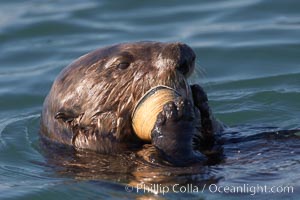
A sea otter eats a clam that it has taken from the shallow sandy bottom of Elkhorn Slough. Because sea otters have such a high metabolic rate, they eat up to 30% of their body weight each day in the form of clams, mussels, urchins, crabs and abalone. Sea otters are the only known tool-using marine mammal, using a stone or old shell to open the shells of their prey as they float on their backs.
Species: Sea otter, Enhydra lutris
Location: Elkhorn Slough National Estuarine Research Reserve, Moss Landing, California
Image ID: 21622
Species: Sea otter, Enhydra lutris
Location: Elkhorn Slough National Estuarine Research Reserve, Moss Landing, California
Image ID: 21622
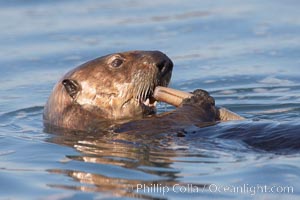
A sea otter eats a clam that it has taken from the shallow sandy bottom of Elkhorn Slough. Because sea otters have such a high metabolic rate, they eat up to 30% of their body weight each day in the form of clams, mussels, urchins, crabs and abalone. Sea otters are the only known tool-using marine mammal, using a stone or old shell to open the shells of their prey as they float on their backs.
Species: Sea otter, Enhydra lutris
Location: Elkhorn Slough National Estuarine Research Reserve, Moss Landing, California
Image ID: 21640
Species: Sea otter, Enhydra lutris
Location: Elkhorn Slough National Estuarine Research Reserve, Moss Landing, California
Image ID: 21640
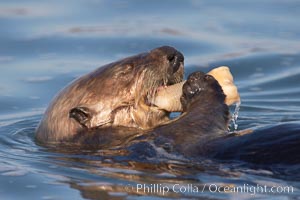
A sea otter eats a clam that it has taken from the shallow sandy bottom of Elkhorn Slough. Because sea otters have such a high metabolic rate, they eat up to 30% of their body weight each day in the form of clams, mussels, urchins, crabs and abalone. Sea otters are the only known tool-using marine mammal, using a stone or old shell to open the shells of their prey as they float on their backs.
Species: Sea otter, Enhydra lutris
Location: Elkhorn Slough National Estuarine Research Reserve, Moss Landing, California
Image ID: 21652
Species: Sea otter, Enhydra lutris
Location: Elkhorn Slough National Estuarine Research Reserve, Moss Landing, California
Image ID: 21652
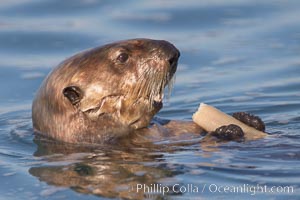
A sea otter eats a clam that it has taken from the shallow sandy bottom of Elkhorn Slough. Because sea otters have such a high metabolic rate, they eat up to 30% of their body weight each day in the form of clams, mussels, urchins, crabs and abalone. Sea otters are the only known tool-using marine mammal, using a stone or old shell to open the shells of their prey as they float on their backs.
Species: Sea otter, Enhydra lutris
Location: Elkhorn Slough National Estuarine Research Reserve, Moss Landing, California
Image ID: 21660
Species: Sea otter, Enhydra lutris
Location: Elkhorn Slough National Estuarine Research Reserve, Moss Landing, California
Image ID: 21660
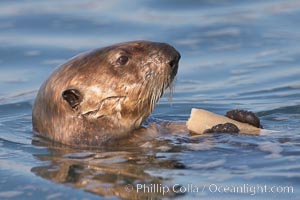
A sea otter eats a clam that it has taken from the shallow sandy bottom of Elkhorn Slough. Because sea otters have such a high metabolic rate, they eat up to 30% of their body weight each day in the form of clams, mussels, urchins, crabs and abalone. Sea otters are the only known tool-using marine mammal, using a stone or old shell to open the shells of their prey as they float on their backs.
Species: Sea otter, Enhydra lutris
Location: Elkhorn Slough National Estuarine Research Reserve, Moss Landing, California
Image ID: 21661
Species: Sea otter, Enhydra lutris
Location: Elkhorn Slough National Estuarine Research Reserve, Moss Landing, California
Image ID: 21661
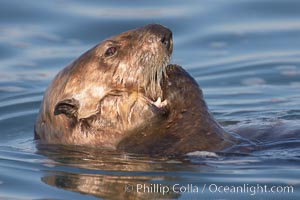
A sea otter eats a clam that it has taken from the shallow sandy bottom of Elkhorn Slough. Because sea otters have such a high metabolic rate, they eat up to 30% of their body weight each day in the form of clams, mussels, urchins, crabs and abalone. Sea otters are the only known tool-using marine mammal, using a stone or old shell to open the shells of their prey as they float on their backs.
Species: Sea otter, Enhydra lutris
Location: Elkhorn Slough National Estuarine Research Reserve, Moss Landing, California
Image ID: 21662
Species: Sea otter, Enhydra lutris
Location: Elkhorn Slough National Estuarine Research Reserve, Moss Landing, California
Image ID: 21662
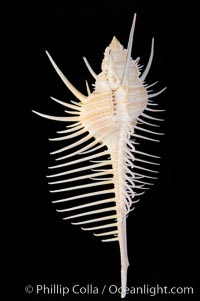
Venus comb murex. Scientists speculate that the distinctively long and narrow spines are a protection against fish and other mollusks and prevent the mollusk from sinking into the soft, sandy mud where it is commonly found.
Species: Venus comb murex, Murex pecten
Image ID: 12971
Species: Venus comb murex, Murex pecten
Image ID: 12971
